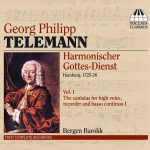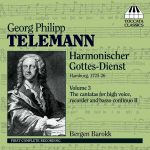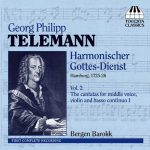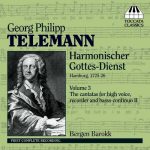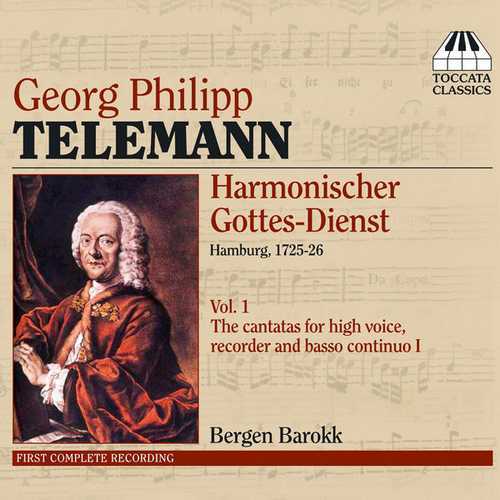
Composer: Georg Philipp Telemann
Performer: Bergen Baroque, Mona Julsrud, Frode Thorsen, Markku Luolajan-Mikkola, Hans Knut Sveen
Format: FLAC (tracks)
Label: Toccata Classics
Catalogue: TOCC0037
Release: 2006
Size: 303 MB
Recovery: +3%
Scan: cover
Lauter Wonne, lauter Freude, TWV 1:1040
01. Aria: Lauter Wonne, lauter Freude
02. Recitative: Dort labet sich ein Kind der Eitelkeit
03. Aria: Ein stetes Zagen, ein ewig’s Nagen
In gering- und rauhen Schalen, TWV 1:941
04. Aria: In gering- und rauhen Schalen
05. Recitative: O Eitelkeit, du kluger Sterblicher
06. Aria: Nicht uns, nein, nein, nur dir allein
Hemmet den Eifer, verbannet die Rache, TWV 1:730
07. Aria: Hemmet den Eifer, verbannet die Rache
08. Recitative: Was heisst, du sollst nicht ehebrechen
09. Aria: Ja, ja, ich will den Nachsten lieben
Seele, lerne dich erkennen, TWV 1:1258
10. Aria: Seele, lerne dich erkennen!
11. Recitative: Ein Vogelchen, dem noch die Glieder
12. Aria: So will ich dich mit Freuden kussen
Du bist verflucht, o Schreckensstimme, TWV 1:385
13. Aria: Du bist verflucht, o Schreckensstimme
14. Recitative: So ist’s: Seitdem bei Edens Baum des ersten Menschen erste Sunde
15. Aria: Frohlocket, ihr seligen Kinder der Freien!
Auf ehernen Mauern, TWV 1:96
16. Aria: Auf ehernen Mauern, auf marmornen Grunden
17. Recitative: So lange noch der Unbestand den Schuchternen
18. Aria: Ja, ja, wiederholt nur eure Tucke?
This is the first CD in the first complete recording of the 72 cantatas from Georg Philipp Telemann’s collection Harmonischer Gottes-Dienst, published in Hamburg in 1726 – the first complete set of cantatas for the liturgical year to be published. The cantatas are designated for voice, an obbligato instrument (recorder, violin, transverse flute or oboe) and basso continuo, and take the form of two da capo arias with an intervening recitative. Although intended for worship, both public and private, Telemann’s cantatas are a masterly blend of tunefulness with skilled counterpoint and vocal and instrumental virtuosity.
Toccata Classics’ Telemann: Harmonischer Gottes-Dienst, Vol. 1, promises to be the opening salvo in a most ambitious project, provided Toccata stays in business this long — a complete recording of Georg Philipp Telemann’s 1725 publication Harmonischer Gottes-Dienst (The Harmonious Service to God). This is a collection of 72 solo cantatas laid out for every Sunday and holiday of the Lutheran church year, composed to fit a text based on a Bible verse appropriate to each occasion. This was the first complete cantata cycle of at least three published by Telemann, and a couple of other nearly complete cycles exist in manuscript, along with literally hundreds of single sacred cantatas by him scattered in sources throughout Europe. The lean forces required by the Harmonischer Gottes-Dienst — solo vocalist, a solo instrument or two, keyboard, and continuo — was what made the edition both practical and popular.
Telemann’s music was tuneful and relatively easy to play, designed for the second cantata in a service following the sermon, by which time hired-in musicians would have skirted off to play in a service elsewhere. The impact and range of influence of the Harmonischer Gottes-Dienst was enormous, and it was still in regular use three decades or more after it first appeared. One can hardly think of a large Baroque collection of sacred music that needs recording worse than this one, although that in itself is a daunting prospect; judging by the standards of Telemann: Harmonischer Gottes-Dienst, Vol. 1, performers, Bergen Barokk will reach the end of the cycle some 12 CDs from now.
Nevertheless, this is an incredibly good start. Bergen Barokk seems to have found the ideal soprano in Mona Julsrud, who has a clear, transparent, and flexible voice that never devolves into modern, operatic-style singing, but is capable of delivering drama where it belongs, such as in the stormy cantata for Laetare (The Fourth Sunday of Lent), Du bist verflucht, o Schreckensstimme. Julsrud also has the ability to differentiate between different, but closely related kinds of vocal ornaments, as in the cantata for the Fourth Sunday of Advent, Lauter Wonne, lauter Freunde. Soloist Frode Thorsen on recorder plays sweetly, but not shrilly, and never dominates the music, even in passages where he appears to be the star attraction. The continuo playing by Hans Knut Sveen and Markku Luolajan-Mikkola is alternatively spirited and sensitive without being over-decorated or bored sounding.
Leaving nothing to bothersome uncertainty for consumers coming to grips with this literature for the first time, as most will be, the book supplied with Telemann: Harmonischer Gottes-Dienst, Vol. 1, will satisfy even expert listeners. Full texts and translations are provided, along with a discussion of the text authors, an attribute badly needed when sacred cantatas are under consideration, and yet one almost never explored, or exploited, by record companies. There are even mini-reproductions of original score pages and a link provided for those who want to observe the printed music in an online edition. All in all, Telemann: Harmonischer Gottes-Dienst, Vol. 1, is a great start to what looks to be a promising series, and if subsequent volumes maintain this level of inspiration and dedication, then Telemann fans are going to have to make a lot of room on their record shelves.
